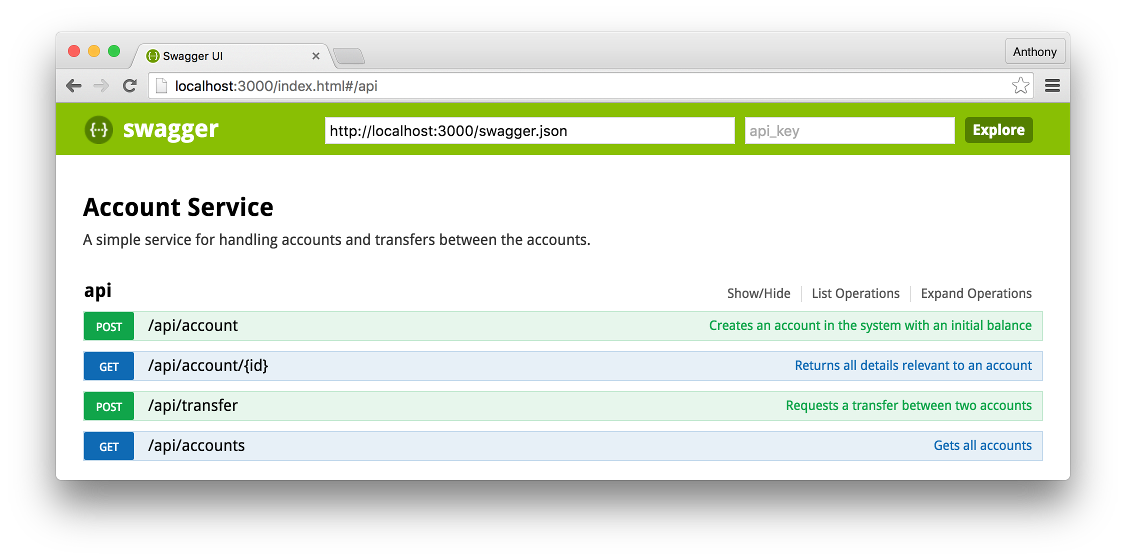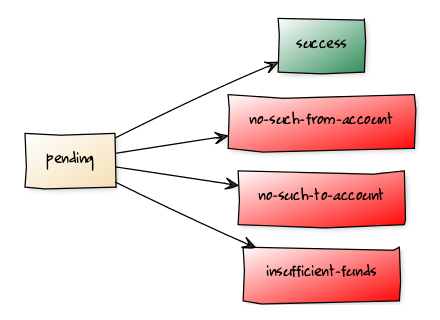Using Datomic in a simple use case
Jun 16, 2016 · 8 minute read clojureIn a previous post, we started building an account service in Clojure using compojure-api. In this post, we will add persistence using Datomic. The sources are available on GitHub. For an introduction to Datomic as well as the value-proposition behind it, you should take a look at the training resources on the Datomic website. If the videos are too much of an investment at this stage, you might want to take a look at Daniel Higginbotham’s article Datomic for Five Year Olds. Just as a quick reminder, the service should support creating accounts and transferring money from one account to another. Here are the Swagger docs for the API:

The Schema
We will start by defining the schema for Datomic. Under the resources folder, create a file named schema.dtm. This will hold the Datomic schema definition. An account only has one field: balance:
{:db/id #db/id[:db.part/db]
:db/ident :account/balance
:db/valueType :db.type/bigdec
:db/cardinality :db.cardinality/one
:db/doc "An account's balance"
:db.install/_attribute :db.part/db}For transfers we need: from-account, to-account, amount:
{:db/id #db/id[:db.part/db]
:db/ident :transfer/amount
:db/valueType :db.type/bigdec
:db/cardinality :db.cardinality/one
:db/doc "A transaction's amount"
:db.install/_attribute :db.part/db}
{:db/id #db/id[:db.part/db]
:db/ident :transfer/from-account
:db/valueType :db.type/ref
:db/cardinality :db.cardinality/one
:db/doc "An account from which to transfer money"
:db.install/_attribute :db.part/db}
{:db/id #db/id[:db.part/db]
:db/ident :transfer/to-account
:db/valueType :db.type/ref
:db/cardinality :db.cardinality/one
:db/doc "An account to which to transfer money"
:db.install/_attribute :db.part/db}We will also use an additional field called status to keep track of what happened to a transfer request:
{:db/id #db/id[:db.part/db]
:db/ident :transfer/status
:db/valueType :db.type/ref
:db/cardinality :db.cardinality/one
:db/doc "The status of a transfer"
:db.install/_attribute :db.part/db}
[:db/add #db/id[:db.part/user] :db/ident :transfer.status/pending]
[:db/add #db/id[:db.part/user] :db/ident :transfer.status/success]
[:db/add #db/id[:db.part/user] :db/ident :transfer.status/insufficient-funds]
[:db/add #db/id[:db.part/user] :db/ident :transfer.status/no-such-from-account]
[:db/add #db/id[:db.part/user] :db/ident :transfer.status/no-such-to-account]The intention is for requests to start in status pending and transition them accordingly based on the outcome of the transaction:

Next create a file under src/account_service called db.clj. In it we :require datomic.api and define the connection to Datomic:
(ns account-service.db
(:require [datomic.api :as d]))
(def uri "datomic:free://localhost:4334/account-service-db")
(def conn (d/connect uri))Testing with Midje
Before we implement any of the functionality to deal with datomic let’s write some tests. Create a file named db_test.clj under test/account_service:
(ns account-service.db-test
(:require [account-service.db :refer :all]
[midje.sweet :refer :all]
[datomic.api :as d]))Notice we use the midje and Datomic libraries for our tests so add these dependencies in project.clj, as well as the lein-datomic and lein-midje plugins:
(defproject account-service "0.1.0-SNAPSHOT"
:dependencies [[org.clojure/clojure "1.8.0"]
[com.datomic/datomic-free "0.9.5372"]
[clj-time "0.12.0"]
[expectations "2.1.8"]
[metosin/compojure-api "1.1.2"]]
:plugins [[lein-datomic "0.2.0"]]
:ring {:handler account-service.core/app}
:datomic {:schemas ["resources" ["schema.dtm"]]}
:profiles {:dev
{:plugins [[lein-ring "0.9.7"]
[lein-midje "3.2"]]
:dependencies [[javax.servlet/servlet-api "2.5"]
[cheshire "5.6.1"]
[ring/ring-mock "0.3.0"]
[midje "1.8.3"]]
:datomic {:config "resources/free-transactor.properties"
:db-uri "datomic:free://localhost:4334/account-service-db"}}})Having defined our dependencies, let’s create a function that will allow the tests to work with an in-memory database in core_test.clj:
(defn create-empty-in-memory-db []
(let [uri "datomic:mem://account-service-test-db"]
(d/delete-database uri)
(d/create-database uri)
(let [conn (d/connect uri)
schema (read-string (slurp "resources/schema.dtm"))]
(d/transact conn schema)
conn)))Every time we call this function we are dropping the database, recreating it and applying the schema. Next, let’s write our first test for creating accounts:
(fact "Adding one account should allow us to find that account using the returned id"
(with-redefs [conn (create-empty-in-memory-db)]
(let [account (add-account {:balance 161.80M})]
(get-account (:id account)) => {:id (:id account) :balance 161.80M})))This says we should be able to add an account to the system by providing an initial balance using the function add-account. Also, we should be able to find said account using the function get-account, via the id returned by add-account. with-redefs temporarily redefines conn in db.clj so that the tests use the in-memory database. Before implementing these two methods let’s define one more test:
(fact "Adding multiple accounts should allow us to find all those accounts"
(with-redefs [conn (create-empty-in-memory-db)]
(let [account-1 (add-account {:balance 12.34M})
account-2 (add-account {:balance 56.78M})
account-3 (add-account {:balance 12.34M})]
(get-accounts) => [{:id (:id account-1) :balance 12.34M}
{:id (:id account-2) :balance 56.78M}
{:id (:id account-3) :balance 12.34M}])))Our second test says we should be able to add multiple accounts to the system, and subsequently be able to find all such accounts using the function get-accounts. We can run these tests by switching to the root folder in the shell and executing:
$ lein midjeOf course, the tests fail so let’s proceed to the implementation.
Accounts
Open db.clj and add the add-account function:
(defn add-account
"Adds an account"
[account]
(let [balance (bigdec (:balance account))
res (second (:tx-data
@(d/transact conn
[{:db/id (d/tempid :db.part/user)
:account/balance balance}])))]
{:id (:e res)
:balance (:v res)}))We use the datomic transact function to add an account with a balance. Next we write our get-account and get-accounts functions to retrieve accounts we create using add-account:
(defn get-account
"Retrieves an account given it's id"
[id]
(let [res (first (d/q '[:find ?id ?balance
:in $ ?id
:where [?id :account/balance ?balance]]
(d/db conn)
id))]
{:id (first res)
:balance (second res)}))
(defn get-accounts
"Retrieves all accounts"
[]
(let [res (d/q '[:find ?a ?balance
:where [?a :account/balance ?balance]]
(d/db conn))]
(map #(hash-map :id (first %) :balance (second %)) res)))We use the Datomic q function to perform queries. The query language used is datalog. For an overview of datalog you can check out learndatalogtoday.org. At this point, you should be able to run lein midje in the shell and the tests should be green.
Transfers
Moving on to transfers let’s write some more tests in db_test.clj:
(fact "Making a transfer between two valid accounts with sufficient funds should succeed"
(with-redefs [conn (create-empty-in-memory-db)]
(let [from-account (add-account {:balance 1618.00M})
to-account (add-account {:balance 200.00M})]
(make-transfer {:from-account (:id from-account)
:to-account (:id to-account)
:amount 12.34M}) => (contains {:from-account (:id from-account)
:to-account (:id to-account)
:amount 12.34M
:status :transfer.status/success})
(get-account (:id from-account)) => {:id (:id from-account) :balance (- 1618.00M 12.34M)}
(get-account (:id to-account)) => {:id (:id to-account) :balance (+ 200.00M 12.34M)})))This tests starts by creating two accounts in the system and then proceeds to make a transfer between these accounts. Since the accounts are valid we expect that the transfer succeeds i.e. status is set to transfer.status/success. Let’s now proceed to write some more tests for cases where the transfer fails:
(fact "Making a transfer from an account with insufficient funds should fail with status insufficient-funds"
(with-redefs [conn (create-empty-in-memory-db)]
(let [from-account (add-account {:balance 18.00M})
to-account (add-account {:balance 200.00M})
transfer (make-transfer {:from-account (:id from-account) :to-account (:id to-account) :amount 100.23M})]
(get-transfer (:id transfer)) => {:id (:id transfer)
:from-account (:id from-account)
:to-account (:id to-account)
:amount 100.23M
:status :transfer.status/insufficient-funds})))
(fact "Making a transfer from an account which doesn't exist should fail with status no-such-from-account"
(with-redefs [conn (create-empty-in-memory-db)]
(let [to-account (add-account {:balance 180.00M})
transfer (make-transfer {:from-account 928374 :to-account (:id to-account) :amount 80.23M})]
(get-transfer (:id transfer)) => {:id (:id transfer)
:from-account 928374
:to-account (:id to-account)
:amount 80.23M
:status :transfer.status/no-such-from-account})))
(fact "Making a transfer to an account which doesn't exist should fail with status no-such-to-account"
(with-redefs [conn (create-empty-in-memory-db)]
(let [from-account (add-account {:balance 138.00M})
transfer (make-transfer {:from-account (:id from-account) :to-account 98234619 :amount 100.23M})]
(get-transfer (:id transfer)) => {:id (:id transfer)
:from-account (:id from-account)
:to-account 98234619
:amount 100.23M
:status :transfer.status/no-such-to-account})))When we make a transfer we want to simultaneously update the transfer status as well as the balances in the respective accounts (if the transfer is possible) in a transaction. We implement this transaction using a datomic database function which we define in our schema.dtm:
{:db/id #db/id[:db.part/user]
:db/ident :make-transfer
:db/doc "Performs a transfer between two accounts"
:db/fn #db/fn
{:lang "clojure"
:params [db transfer-id from-account to-account amount]
:code (let [f (datomic.api/entity db from-account)
t (datomic.api/entity db to-account)
f-balance (:account/balance f)
t-balance (:account/balance t)]
(cond
(nil? f-balance) [[:db/add transfer-id :transfer/status :transfer.status/no-such-from-account]]
(nil? t-balance) [[:db/add transfer-id :transfer/status :transfer.status/no-such-to-account]]
(< f-balance amount) [[:db/add transfer-id :transfer/status :transfer.status/insufficient-funds]]
:else [[:db/add transfer-id :transfer/status :transfer.status/success]
[:db/add from-account :account/balance (- f-balance amount)]
[:db/add to-account :account/balance (+ t-balance amount)]]))}}We then use this database function in db.clj by passing it to d/transact:
(defn make-transfer
"Performs a transfer"
[transfer]
(let [amount (bigdec (:amount transfer))
res (second (:tx-data
@(d/transact conn
[{:db/id (d/tempid :db.part/user)
:transfer/from-account (:from-account transfer)
:transfer/to-account (:to-account transfer)
:transfer/amount amount
:transfer/status :transfer.status/pending}])))]
(def x @(d/transact conn [[:make-transfer
(:e res)
(:from-account transfer)
(:to-account transfer)
(:amount transfer)]]))
(get-transfer (:e res))))Now let’s wire the functions we created in db.clj to our API. Go to core.clj and modify the endpoint definitions as follows:
(def app
(api
{:swagger
{:ui "/"
:spec "/swagger.json"
:data {:info {:title "Account Service"
:description "A simple service for handling accounts and transfers between the accounts."}
:tags [{:name "api"}]}}}
(context "/api" []
:tags ["api"]
(POST "/account" []
:return Account
:body [account (describe NewAccount "new account")]
:summary "Creates an account in the system with an initial balance"
(ok (add-account account)))
(GET "/account/:id" []
:path-params [id :- Long]
:return (s/maybe Account)
:summary "Returns all details relevant to an account"
(ok (get-account id)))
(POST "/transfer" []
:return Transfer
:body [transfer (describe NewTransfer "new transfer")]
:summary "Requests a transfer between two accounts"
(ok (make-transfer transfer)))
(GET "/accounts" []
:return [Account]
:summary "Gets all accounts"
(ok (get-accounts))))))At this point you should be able to go to http://localhost:3000/index.html in your browser and interact with the service:

Conclusion
In this post, we have extended the API from an earlier post to use Datomic for persistence. You can find all the source code on GitHub.